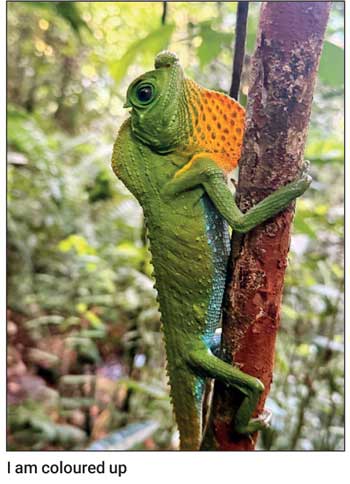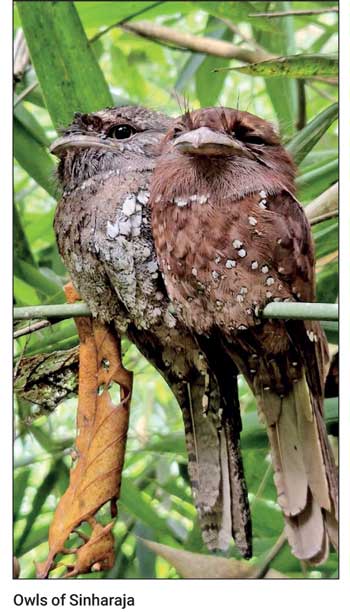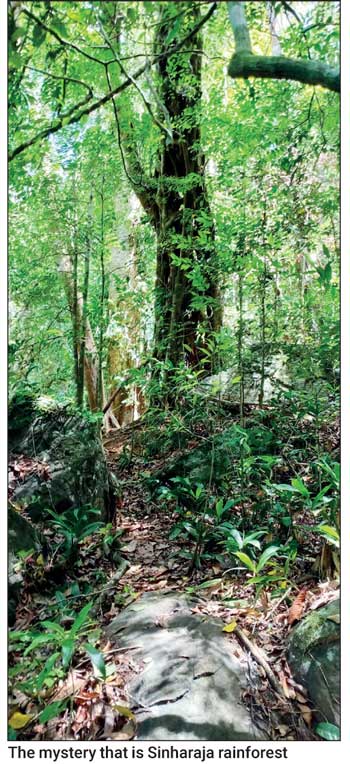Sunday Nov 16, 2025
Sunday Nov 16, 2025
Saturday, 4 October 2025 00:02 - - {{hitsCtrl.values.hits}}
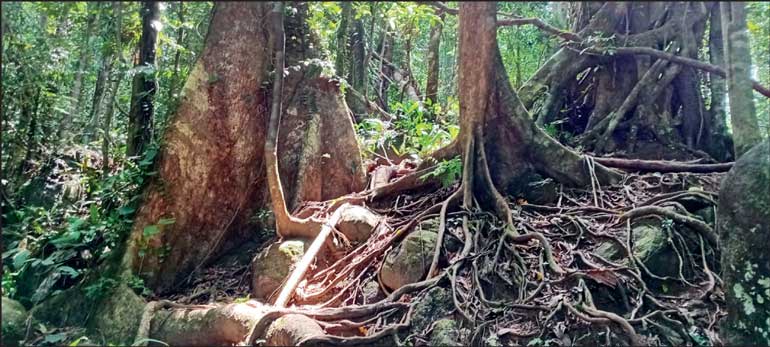
The carpet of the forest
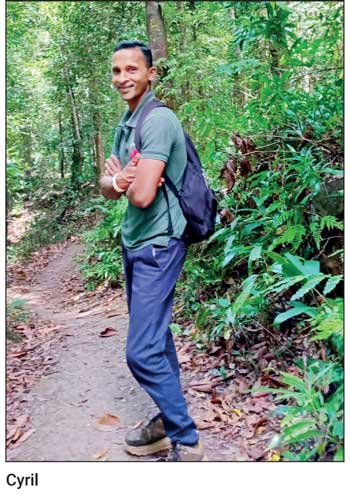 By Surya Vishwa
By Surya Vishwa
Last week we featured in this page, an article on how Artificial Intelligence (AI) can be a boon to humankind in particular situations.
This week we turn in the opposite direction and immerse in the Natural Intelligence (NI) of nature. Of rainforests, to be precise. Rainforests are masses of earth left to its own devices, without the interference of man and nourished by earth’s natural bounty, mainly the rain and the sun which results in the blossoming forth of life in all its mysterious forms. This we call biodiversity. Today we enter the precincts of Sinharaja – a World Heritage Site and the last visible tropical rainforest in Sri Lanka. The Sinharaja rainforest is a key local and foreign attraction in Sri Lanka drawing scores of visitors daily. It is a dense sanctuary that is home to endemic plant life including precious medicinal plants and fascinating creatures of the wild such as rare reptiles, amphibians, insects and birds which could be observed at close quarters as they go about their day in the comfort of their home.
Let us ponder for a while what a forest is and its significance to humans.
Today at the pinch of a computer or phone screen we can find details about ancient wisdom ranging from indigenous medicine, energy harnessing methods of the cosmos through the connection of the body such as yoga and learn about spiritual traditions such as Buddhism. What we forget or do not reflect much, is that all of these realms of knowledge that are now within the reach of Artificial Intelligence were originally created through Natural Intelligence. The influx of the above mentioned knowledge were first borne in the bosom of the primordial – within forests, the one and only (free) luxury that man needs to supply him water, air, medicine and food. A forest therefore was the first teacher of man. It was the first cradle, school, pharmacy, larder and temple. And it will also be the tomb – of all life. If humans kill it, it will breathe its last – along with the final whimper of our so-called advanced civilisation.
The Sinharaja rainforest is a major sustainer of life; its plant life nourishes the earth and thereby keeps healthy the water cycle of the surrounding areas, feeding rivers and streams, preventing soil erosion and absorbing carbon dioxide alongside helping to maintain stable weather patterns. An immense living body of bio-diversity this rainforest has its entrances from Kudawa in Ratnapura, Rakwana, also in Ratnapura, and Pitadeniya in Galle and Matara nearer Deniyaya.
In this journey we enter Sinharaja from Pitadeniya. I am accompanied by Akitha Deshan and Cyril Wickramasinghe, two experienced guides who specialise in ecotourism. Akitha splits his time between coastal areas of Sri Lanka and Deniyaya which is his home. Cyril who is from an adjoining village, spends much of his waking hours in the Sinharaja forest. It is his comfort zone – his home without a roof. Akitha and Cyril sometimes work together and with many other guides as well. Forest guides sometimes function in duos so that one could point out a piece of forest based information, folklore or wisdom that the other may miss. Generally if the group is small the guides do the tour alone as well.
“I grew up with this forest and its periphery. I am from Mediripitiya and I used to accompany my father almost everyday into the wilderness that enshrouds our area, mostly to gather firewood or edibles and medicinal leaves. Over 30 years ago there was no tourism as such in our villages as there is now. There were no lodges or hotels. This area was not full of guides as we see now. It was a very dense area with scattering of villages and we lived in affinity to the wilderness and its non-human inhabitants. We did not have modern appliances in kitchens. We collected firewood and we learnt not to trespass on creatures such as reptiles and learnt very early in age that many of them were not as poisonous as humans! Much of our food came from the purity of earth – without the interferences of man.”
 As Cyril speaks Akitha has moved on and stands still several feet away, head turned upwards obviously admiring some skyborne creature. We are still en-route to the Pitadeniya entrance of Sinharaja where we pass many locals, guides, foreigners and hotels.
As Cyril speaks Akitha has moved on and stands still several feet away, head turned upwards obviously admiring some skyborne creature. We are still en-route to the Pitadeniya entrance of Sinharaja where we pass many locals, guides, foreigners and hotels.
Cyril continues speaking.
Genuine love of the forest
He is singing the praises of a forest found food; Beraliya. You can clean the seed, dry and pound it so that it can be used as an alternative to flour. It can especially be used to make sweetmeat. And look, those are the dragonflies; the Iratukura and the Bathkura. They place their eggs in water but they are almost extinct today because of the pesticide and the weedicide.”
In a world where humans act almost like machine it is a pleasure to watch those such as Akitha and Cyril. They are absorbed in the grandeur of their primary home, the forest. There is nothing mechanical in how they explain their home to you. I observe a trail of many guides, as they quicken their step to take on the tours for the day. Few of them have an air of drudgery as they walk busily with the visitors, mostly foreigners. What is the difference? Passion. And genuine love of the forest.
Neither Akitha nor Cyril have uttered one word to me about money i.e. my payment. As we approach the entrance of the forest where the ticket counter is, Cyril is quicker than me to flick open his wallet to get the needed cash out. I have to force him to take a small payment as a monetary reward for showing me the forest and its inhabitants.
It turns out that they have also got eatables and some fruit juice.
They laugh as they reveal that even when they have no tourist or local visitor that they sometimes come to the heart that comforts them no matter the grief. I contemplate their complete lack of artifice and the joy in their faces as they regale me with the stories of the rainforest.
The Sinharaja forest, Cyril and Akitha inform me, is the shared territory of Sumana Saman Deviyo – the generally linked deity of this haven of wilderness – and also Kohomba Devi Hamuduruwo.
“This forest overall belongs to the Sumana Saman god – however there is a smaller area that is considered as the stringent territory of the Kohomba Devi Hamuduruwo. While god Sumana Saman is the guardian of those who do good, Kohomba Devi Hamuduruwo is the patron of those who do the opposite of good,” grins Cyril.
“So, it means that those who do good cannot go to the opposite territory and vice versa,” he concludes with the air of someone who does not question the mystical rules of forest. I gingerly query as to which section they are taking me to; I have not quite made up my mind if I am a ‘good’ person or a ‘bad’ one!
Soon we halt. We are in the way of a glistening Green Pit Viper, who apparently is not that poisonous. It minds its own business and slinks off.
Cyril and Akitha decide that it is better for me that I wear the leech socks that they have got for me – stitched with material the blood thirsty creepy crawlies cannot get through to. I follow their instructions and don the socks on and apply salt on the shoes for extra protection. But when I ask why they themselves do not follow suit, I am greeted with a laugh.
“We are here so much that it is the leeches who are afraid of us,” quips Akitha.
We are still in the interior that is not far from the entrance of the forest and decide to spend about three hours walking as far as this time would take us. The world as we knew it is behind us. We are now in a different realty. The voices of humans are taken over by the orchestra of the forest; the rustling of the wind, the falling of leaves, the buzz of insects, the chirp of a bird, merge with silence. I wonder for the thousandth time – as I have as a writer, what the outcome would be if our ‘schools,’ ‘universities,’ and ‘hospitals’ were forests instead of cement prisons.
Soon we meet two brothers of a differing kind. The Kangaroo Lizard and the Whistling Lizard. One jumps – its tail is long and hands short. The other whistles. They sleep on a leaf, just as we do on a bed, explains Akitha. And I look into the irate eyes of a drowsy lizard wobbling on a leaf.
“This is a lazy one. They usually are active in the day and sleep at night,” points out Akitha.
We tread on, blending into the depths of Sinharaja. Cyril informs that there are several varieties of owls in Sri Lanka; such as the Serendib Scops Owl which is endemic to Sri Lanka and the Chestnut Black Owl – where it can turn its head right to the back and the Frog Mouth Owl. There is also the Sri Lankan Bay Owl which is a rarer find in Sinharaja.
As we walk further inward into the forest, we see a myriad of scenes. Long vines hanging from large trees, various creepers of multifarious proportions encircling trees, and long trunks of trees that lie across like slain humans.
Power struggles, battles for land, for supremacy
“Well, all the kinds of things that happen in our world, happen here too,” shrugs Cyril.
“There are power struggles, battles for land, for supremacy. There are some creepers and wewel that over time bring down seemingly sturdy and majestic trees. Look. See. Those trees. The creepers and vines that wound round them slowly gave the tree the death sentence.”
I sigh. So there are wars here too.
“Oh yes. Different wars happen here too. It is not all peace as it seems,” philosophises Akitha.
Soon we come across an enigmatic reptile. The Ahatulla or the Asgulla. The common belief is that it can pull the human eyes out of the sockets. This is what the name Asgulla means. However in everyday life the creature is not so ominous. Its main specialty is that it can unite its eyes. Although slightly venomous, it cannot do any serious harm, explains Cyril.
We next confront a mini train – a black coloured Melepede.
“If you touch it, it has no impact on your skin. It is only the Centipede which is venomous. A grown centipede can have even over 300 feet,” states Akitha.
Our gaze next falls on the Hump Nose Lizard. We look at it from different angles and smile at how it clutches onto the tree branch it is on.
We soon see flowing waters; it is the Gin Ganga that starts from highlands of Gonagala on the Rakwana-Deniyaya Ratnapura route.
As we proceed, we witness how the magnificence of the Sinharaja rainforest is revealed as it blends with each turn into a chiaroscuro of hues. From the depths of dark brown it turns green and gold – in the airy sunny spots and then back again merges to become a compressed blur of colours.
As we part branches and move on, we are eye to eye with an apparently enraged female garden lizard (named thus because it is usually also found in areas of foliage). It is a colourful apparition when the neck of the female swells to a yellowy hue when angry. It is obviously very angry to see us.
We walk on. Overawed by the trees that look so regal with vast spread of roots like large carpets that I go and sit awhile near one. I ask about elephants and am told that there are two elephants known to be within the Pothupitiya side of the forest.
As we sit awhile in silence the music of the rainforest overtakes us. It is a subtle web of sound that has an eclectic quality – if one sits in awareness it becomes completely audible and takes over the senses.
We spot a Reheyya (forest moth). We see several and marvel at the dazzling sheen of their wings.
As we walk further there are now more of felled trees.
“These are mostly done by wewel – they absorb water and monopolise the trees. They then gradually bind the tree and pull it down,” explains Cyril.
We now clearly see the canopies of the forest where the upper echelons get sunlight and the tallest trees rise high exposed unencumbered to sunlight. These are graced by many birds. The lower cover of greenery forms the sub canopy where many of the creatures we have been seeing so far are sheltered and down below in the forest floor is the dense shrubbery that gets the dregs of sunlight and thereby is often damp and humid.
As we venture onwards we see the rest of the tapestry of the forest – the moss, mushrooms, ferns, climbers and vast tree trunks. Some have hollows formed by fungi and bacteria, creating intriguing formations; the grandest art installation of the world is surely in its rainforests. Meanwhile time has sped.
We have now arrived at the long bridge that will bring us to the office and the bungalows of the forest department.
This will be our story for next week. We will look at the role of the Forest Department concerning the rainforests of Sri Lanka, examining the importance of both local and tourist visits to Sinharaja and the need to safeguard the forest territories. We will also ideate on what could be done to protect, promote and sensitise humans through tourism on the relevance of rainforests – in Sri Lanka and the world for healthier humans and planet.
